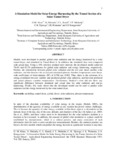| dc.description.abstract | Models were developed to predict global solar radiation and the energy harnessed by a solar tunnel dryer, and simulated in Visual Basic 6. In addition, the simulated data were compared with actual data. Using a 10% absolute residual error interval, the developed model achieved 78.4% and 83.3% performance for global solar radiation and energy harnessing, respectively. Further, the relationship between global solar radiation and the ten year mean satellite solar radiation, and that between the actual and simulated plenum chamber temperatures were linear, with coefficients of determination (R2) of 0.788 and 0.962. Thus, there is the existence of a strong correlation between satellite and predicted global solar radiation, and between predicted and actual plenum chamber temperatures. Furthermore, Student’s t-test did not show any significant difference between simulated and actual data for solar radiation and energy harnessing. Finally, this study shows that the developed model can be used to predict solar radiation and the energy harnessed by the solar tunnel dryer. | en_US |

